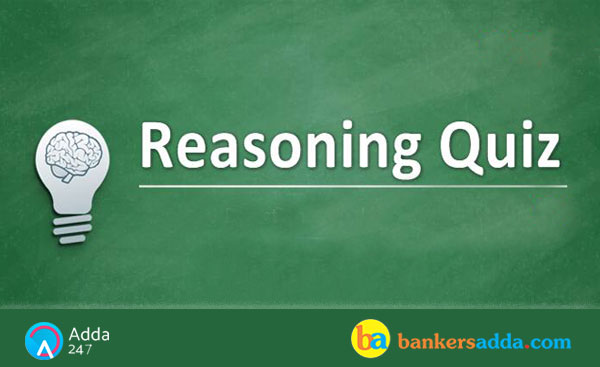Reasoning Ability is an onerous section. With the increasing complexity of questions, it becomes hard for one to give it the cold shoulder. The only way to make the grade in this particular section in the forthcoming banking exams like Indian Bank PO Mains is to practice continuously with all your heart and soul. And, to let you practice with the best of the latest pattern questions, here is the Adda247 Reasoning Quiz based on the exact same pattern of questions that are being asked in the exams.
Directions (1-5): Study the information carefully and answer the questions given below.
Eight shopkeepers M, N, O, J, K, L, U, and V have shops on different floors of a building such that ground floor is numbered as 1 and topmost is numbered as 8. They sell different products i.e. Shirts, Skirts, Trousers, Jeans, Jackets, Sweater, Shoes and T-shirts (not necessarily in same order). U lives immediately below O. No one lives between N’s floor and V’s floor. Only two persons live between N’s and K’s floor. The one, who sells Jackets lives on immediately above the floor on which M lives. The one who sells Shirts lives on first floor. J does not live immediately above and below K. Only one person lives between the persons who sell Shoes and T-shirts. K lives either on 1st floor or Top floor. The one, who sells Skirts lives immediately above the floor on which the person who sells Jackets. V sells Jeans but does not live below N’s floor. K doesn’t live on an even numbered floor. Only four persons live between K’s floor and M’s floor. L sells Sweater and M sells Shoes.
Q1. Who among the following sells Skirt?
Q2. Who among the following lives on third floor?
Q3. L lives on which of the following floor?
Q4. How many persons live between L’s floor and U’s floor?
Q5. Who among the following sells T-shirts ?
Q6. In the following question a statement is given followed by three statements numbered as I, II and III. You have to read all three statements and decide which of them strengthens or weakens the statement.
Statement: Among the governments, there is a strong policy emphasis on improving living conditions in urban areas as more and more people are looking to migrate to semi-urban or rural areas. People are willing to compromise on their standard of living in order to live in a healthier/pollution free environment.
(I)Cities are economically vibrant spaces around the world and drawing a large number of rural migrants looking for better prospects. This is a sustained trend, particularly in developing countries now a day.
(II) A fresh look at urban governance is necessary as migration from rural areas picks up pace. (III) The rate of migration has shown a consecutive decline in the last three Censuses. It was possible that this slow-down signalled the worsening conditions in urban slums, where most of the rural immigrants were concentrated.
For II- Statement II weaken the given statement as according to it migration from the rural areas is increasing whereas according to the statement, more and more people are willing to migrate to rural/semi-urban areas.
For III- Statement III strengthens the statement is it states that there has been a decline in number of migrants but it is due to the poor condition of urban slum areas, mostly acquired by the migrants and because of the policies of the government.
Q7. The revenue of Company A has been decreasing from past one year while the prices of the products offered by the company have also decreased from past six months. Which of the following cannot be the reason of downfall of the revenue of Company A?
Q8. Today’s children are different from the children of previous generations. They are more interested in playing video games or sitting hours on the play stations than in playing outdoor games. They are more technology oriented. These things are depriving the child from developing their personality. They lack the stamina and strength of the previous generations. Which of the following statement weakens the given statement?
(I)The children of today are mentally active as this has made children much more organized and mature than in previous times.
(II)These gadgets are addicting. They have made the children so much addicted to PC and PS that they do not enjoy the outdoor games anymore.
(III)The children of present time are not physically active. These children are not being a team player anymore, they grow up to become shy and introvert instead of being bold and extrovert.
Q9. A committee on reduction of air pollution in the cities of country X has suggested a ban on the use and sales of all the diesel based electricity generators in the cities. Which of the following will be the repercussions, if the suggestion of the committee is implemented?
(b) We don’t know the current levels of pollution in the cities and how much will be the effect of the ban.
(c) There is no doubt the ban will increase the demand for electricity but we don’t know if the government or the private agencies involved in the production will or will not be able to meet the increased demands.
(d) As there will be no further sale of diesel generators in the cities, there will definitely be a reduction in the revenues.
Q10. In question given below three statements are followed by some conclusions. You have to take the given statements to be true even if they seem to be at variance from commonly known facts. Read all the conclusions and then decide which of the given conclusions logically follows from the given statements disregarding commonly known facts.
Statements:
Some rock is stone
Only marble is stone
All marble is limestone
No marble is granite
Conclusions:
I. No stone is granite
II. some rocks can never be granite
III. some limestone being rock is a possibility
Directions (11 –15): In the following questions, the symbols @, $, *, # and % are used with the following meaning as illustrated below.
‘P # Q’ means ‘P is smaller than Q’.
‘P @ Q’ means ‘P is smaller than or equal to Q’.
‘P * Q’ means ‘P is greater than or equal to Q’.
‘P % Q’ means ‘P is equal to Q’.
‘P & Q’ means ‘P is greater than Q’.
Now, in each of the following questions assuming the given statements to be true, find which of the two Conclusions I and II given below them is/are definitely true and give your answer accordingly.
Q11. Statements:
I # A ; A & B & C* D@ E; B&F ;E#H ;G&D
Conclusions:
I. A&D
II. D#H
II.D#H(True)
Q12. Statements:
S & R & L; L & M @ N * O % P & Q ; N # T
Conclusions:
I. T&Q
II. T%Q
II.T%Q(False)
Q13. Statements:
V # P ; S % U ; W % R ; P & Q * R @ S % T
Conclusions:
I. T @ W
II. R* V
II.R*V(False)
Q14. Statements:
N* T * R % J & C ; L # J ; R & F # M ; N # S
Conclusions:
I. F # S
II. N % J
II. N%J(False)
Q15. Statements:
F # L ; H * C # G ;A & B # C * D @ E % F
Conclusions:
I. A @ L
II. A & L
II. A&L(False)






 The Hindu Review October 2022: Download ...
The Hindu Review October 2022: Download ...
 Data Interpretation Questions for SBI PO...
Data Interpretation Questions for SBI PO...
 IBPS PO Vacancy 2024, Check Revised Cate...
IBPS PO Vacancy 2024, Check Revised Cate...




